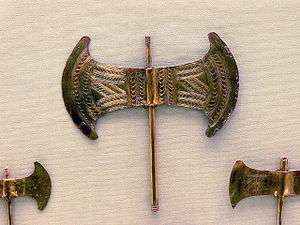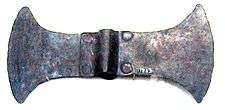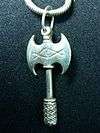Labrys

Labrys (Greek: λάβρυς, lábrus) is, according to Plutarch (Quaestiones Graecae 2.302a), the Lydian word for the double-bitted axe called in Greek a πέλεκυς (pélekus). The relation with the labyrinth is uncertain. [1]
Etymology
Plutarch relates that the word labrys was a Lydian word for "axe": Λυδοὶ γὰρ ‘λάβρυν’ τὸν πέλεκυν ὀνομάζουσι.[lower-alpha 1][2] The word probably appears in Linear B inscriptions, and it may be Minoan. [3] Many scholars including Evans assert that the word labyrinth is derived from labrys, so implies "house of the double axe".[4] A priestly corporation in Delphi was named "Labyades". The original name was probably "Labryades",servants of the double axe. In Roman times at Patrai and Messene they worshipped a goddess Laphria identified with Artemis. Her name was said to be derived from the region around Delphi. [5][6]
However in Crete the "double axe" is not a weapon and always accompanies women and not a male god. [7] Beekes, finds speculative the relation with labrys, and more possible the relation with "lavra" (λαύρα), narrow street. [8] It is also possible that the word labyrinth is derived from the Egyptian loperohunt, meaning palace or temple by the lake. The Egyptian labyrinth near Lake Morris is described by Herodotus and Strabo. [9] . The inscription in Linear B 𐀅𐁆𐀪𐀵𐀍𐀡𐀴𐀛𐀊, on tablet ΚΝ Gg 702, reads da-pu2-ri-to-jo-po-ti-ni-ja. The conventional reading is λαβυρίνθοιο πότνια ("mistress of the labyrinth"). According to some modern scholars it could be read *δαφυρίνθοιο, or something similar, without certain link with either the λάβρυς or the labyrinth. [lower-alpha 2]
A link has also been posited with the double axe symbols at Çatalhöyük, dating to the neolithic age.[10] In Labraunda of Caria the double-axe accompanies the storm-god Zeus Labraundos.[lower-alpha 3][11]
The Minoan Double Axe

In ancient Crete, the double axe was an important cultic symbol. [12] In Crete it never accompanies male gods, but always female goddesses. It seems that it was the symbol of the arche of the creation ( Mater-arche).[13]
Double Axes in the Near East
In the Near East and other parts of the region, eventually, axes of this sort are often wielded by male divinities and appear to become symbols of the thunderbolt,[14] a symbol often found associated with the axe symbol. In Labraunda of Caria the double-axe accompanies the storm-god Zeus Labraundos. Similar symbols have been found on plates of Linear pottery culture in Romania.[15] The double-axe is associated with the Hurrian god of sky and storm Teshub. His Hittite and Luwian name was Tarhun.[16] Both are depicted holding a triple thunderbolt in one hand, and a double axe in the other hand.[17] Similarly, Zeus throws his Keravnos to bring storm. The labrys, or pelekys, is the double axe Zeus uses to invoke storm, and the relative modern Greek word for lightning is star-axe (ἀστροπελέκι astropeleki)[18] The worship of it was kept up in the Greek island of Tenedos and in several cities in the south-west of former Hellenic Asia Minor, and it appears in later historical times in the cult of the thunder god of Asia Minor (Zeus Labrayndeus).
Ancient Greece
In the context of the Classical Greek myth of Theseus, the labyrinth of Greek mythology is frequently associated with the Minoan palace of Knossos. This is based on the unlikely reading of Linear B da-pu2-ri-to-jo-po-ti-ni-ja as λαβυρίνθοιο πότνια ("mistress of the labyrinth").[lower-alpha 4] Even if that is the correct reading, there is no evidence to suggest that this referred to Knossos itself, as is often asserted. It could equally be a smaller sanctuary, or else an entirely separate location.[lower-alpha 5] Ignoring all the difficulties in assuming that labyrinth can be interpreted as "place of the double axes" there is moreover no reason to think this should be Knossos; many more have been found, for example, at the Arkalachori Cave, where the famous Arkalochori Axe was found. Ultimately, only a fragile chain of conjecture can link Theseus to the word labrys.
On Greek coins of the classical period (e.g. Pixodauros, etc.) a type of Zeus venerated at Labraunda in Caria that numismatists call Zeus Labrandeus (Ζεὺς Λαβρανδεύς) stands with a tall lotus-tipped sceptre upright in his left hand and the double-headed axe over his right shoulder.
Roman Crete
In ancient Roman Crete, the labrys was often associated with the mythological Amazons.[19]
Modern uses


Religion and spirituality
It is sometimes used as a symbol of Hellenic Polytheism.
As a symbol of the Goddess movement, the labrys represents the memory of pre-patriarchal matristic societies.[20]
Social movement
In feminist interpretations, the labrys is a symbol of matriarchy.[lower-alpha 6][21]
Since the 1970s, it has been used by the lesbian community as a lesbian feminist symbol to represent women's strength and self-sufficiency.[22][23][24][25][26]
In Kyrgyzstan, "Labrys" is an LGBTIQA rights organization. The group's goal is to improve the quality of life for all LGBTIQA individuals in their country as well as Central Asia.[27]
Culture
It is used by Cretan folklore preservation societies and associations both in Greece and abroad, on occasion with the modern Greek spelling "lavrys".
Political
In Greece, the labrys was employed as a symbol of Metaxism.[28] During the totalitarian period of the 4th of August Regime (1936–1941), it represented the regime-sponsored National Organization of Youth (EON), as its leader, Ioannis Metaxas, believed it to be the first symbol of all Hellenic civilizations.[28]
In the 1960s the labrys was also used by the Italian neo-fascist and far-right movement Ordine Nuovo, most prominently on their flag.
Weapon
While double axes are common in modern high fantasy settings, in reality they were not commonly used in combat.
See also
| LGBT symbols |
|---|
| Flags |
| Other symbols |
Notes
- ↑ "Herakles, having slain Hippolyte and taken her axe away from her with the rest of her arms, gave it to Omphale. The kings of Lydia who succeeded her carried this as one of their sacred insignia of office, and passed it down from father to son until it was passed to Candaules, who disdained it and gave it to one of his companions to carry. When Gyges rebelled and was making war upon Candaules, Arselis came with a force from Mylasa to assist Gyges; Arselis then slew Candaules and his companion and took the axe to Caria with the other spoils of war. And, having set up a statue of Zeus, Arselis put the axe in his hand and invoked the god, Labrandeus".
- ↑ See Melena's overview in the third volume of the Companion to Linear B, p. 73 (available here).
- ↑ "It seems natural to interpret names of Carian sanctuaries like Labranda in the most literal sense as the place of the sacred labrys, which was the Lydian (or Carian) name for the Greek πέλεκυς [pelekys], or double-edged axe." And, "On Carian coins, indeed of quite late date, the labrys, set up on its long pillar-like handle, with two dependent fillets, has much the appearance of a cult image."[11]
- ↑ For the problems with this, see the "Etymology" section above.
- ↑ cf. the parallel construction of a-ta-na-po-ti-ni-ja, perhaps referring to the “Mistress of Athens”, i.e. Athena, on a different tablet (KN V 52) from Knossos.
- ↑ The forms taken by the labrys were classified by Caterina Mavriyannaki.
References
- ↑ Beekes, Robert (2010). Etymological Dictionary of Greek. Boston: Leiden Brill. p. 819.
- ↑ Plutarch, Greek Questions, 45 2.302a.
- ↑ Younger John: DA-PU ..
- ↑ The Oxford Classical Dictionary (4th ed.). Oxford: Oxford University Press. 2012. p. 960. ISBN 978-0199545568.
- ↑ Sweeney, Emmet John (2009). Gods, Heroes and Tyrants: Greek Chronology in Chaos. Algora Publishing. p. 116. ISBN 9780875866826.
- ↑ Platon, Nicolas; Tournay, Béatrice de (2015-05-18). La Civilisation égéenne -: Le Bronze récent et la civilisation mycénienne. Albin Michel. p. iii. ISBN 9782226341075.
- ↑ Nilsson VolI, p. 277
- ↑ Beekes. Greek Etymological dictionary, p.819
- ↑ H.G.Wunderlich. The secret of Crete. (1975). Souvenir Press ltd. p.54
- ↑ Schachermeyr, Fritz (1964). Die minoische Kultur des alten Kreta. Stuttgart: W. Kohlhammer Verlag. p. 161.
Abb.85
OCLC: 325167 - 1 2 Arthur Evans, "Mycenaean tree and pillar cult and its Mediterranean relations," Journal of Hellenic Studies XXI, pp 108, 109.
- ↑ Rutter, Jeremy (2017-11-29). "Minoan Religion".
- ↑ Schachermeyr, Fritz (1964). Die minoische Kultur des alten Kreta. Stuttgart: W. Kohlhammer Verlag. p. 161. OCLC: 325167
- ↑ Dartmouth College: Minoan Religion
- ↑ Schachermeyr, Fritz (1964). Die minoische Kultur des alten Kreta. Stuttgart: W. Kohlhammer Verlag. p. 162. OCLC: 325167
- ↑ Tarhun
- ↑ Teshub
- ↑ M. Nilsson (1967), Die Geschichte der Griechische Religion, Vol. I, C. F. Beck Verlag, Munich, pp. 276–277
- ↑ Francis, Jane E.; Kouremenos, Anna, eds. (2016). "5. The double axe (λάβρυς) in Roman Crete and beyond: the iconography of a multi-faceted symbol". Roman Crete: New Perspectives (1st ed.). Oxford, England; Havertown, Pennsylvania: Oxbow Books. pp. 43–57. ISBN 978-1-78570-095-8.
- ↑ Keller, Mara (1988). "Eleusinian Mysteries" (PDF). Journal of Feminist Studies in Religion (Vol 4 No 1): 42. Retrieved 2016-06-21.
- ↑ Mavriyannaki, Caterina (1983). "La double hache dans le monde hellénique à l'âge de bronze". Revue Archéologique. Nouvelle Série, Fasc. 2 (in French): 195–228. JSTOR.
- ↑ Cottingham, Laura (1996). Lesbians Are So Chic. Bloomsbury. ISBN 9780304337217. Retrieved 26 June 2014.
- ↑ Murphy, Timothy (2013). Reader's Guide to Lesbian and Gay Studies. Routledge. p. 44ff. ISBN 9781135942342. Retrieved 26 June 2014.
- ↑ Morrow, Deana F.; Messinger, Lori (2006). Sexual Orientation and Gender Expression in Social Work Practice: Working with Gay, Lesbian, Bisexual, and Transgender People. Columbia University Press. p. 476. ISBN 9780231127295. Retrieved 26 June 2014.
- ↑ Pea, Georgie (9 August 2013). "LABRYS Tool of Lesbian Feminism". Finding Lesbians. Retrieved 10 July 2018.
- ↑ SwadePages "Origin & History of Gay & Lesbian Symbols"
- ↑ "Labrys". Labrys Kyrgyzstan. 2004–2014. Retrieved 11 May 2016.
- 1 2 Markessinis, Andreas (August 22, 2006). "The Labrys/Pelekys: The symbol of Thundergod Zeus and of the EON". Metaxas Project. Retrieved August 31, 2014.
Further reading
- Cooper, J. C., ed. (1978). An Illustrated Encyclopaedia of Traditional Symbols (1st ed.). London: Thames & Hudson. ISBN 978-0-500-01201-7.
- Cuhulain, Kerr (2004). "Symbols (G-N)". Pagan Protection Center. The Witches' Voice Inc.
- Enszer, Julie (June 26, 2017). "My Labrys, My Self". Argot Magazine.
- "Hellenic nativistic Collective LABRYS". Hellēnismôs. 2015.
- Rapp, Linda (2003). "Symbols" (PDF). glbtq.com.
- "Λατρευτική Κοινότητα ΛΑΒΡΥΣ" (in Greek). Worship community LAVRYS.
External links
| Wikimedia Commons has media related to Labrys. |
- Labrys at Oxford Dictionary, Oxford University Press
- Labrys at Ancient-Symbols.com